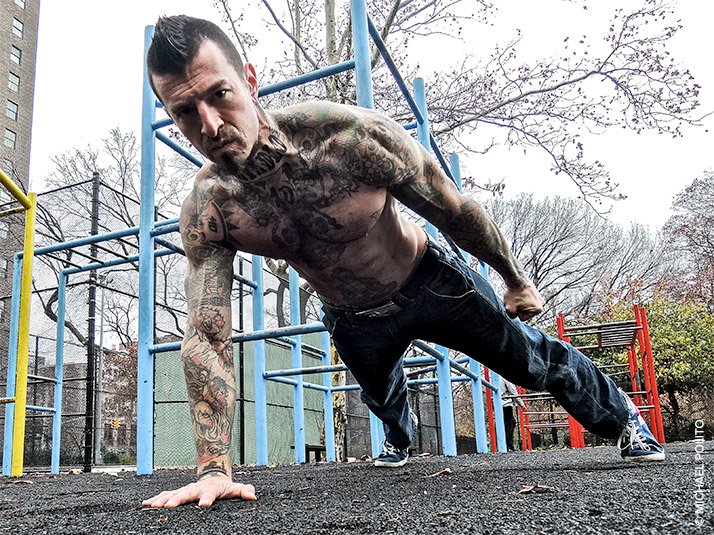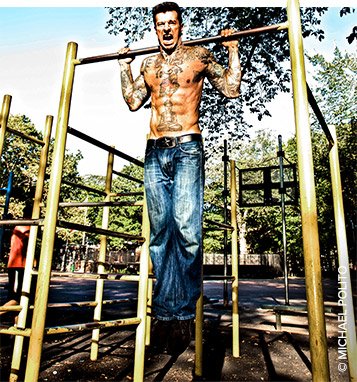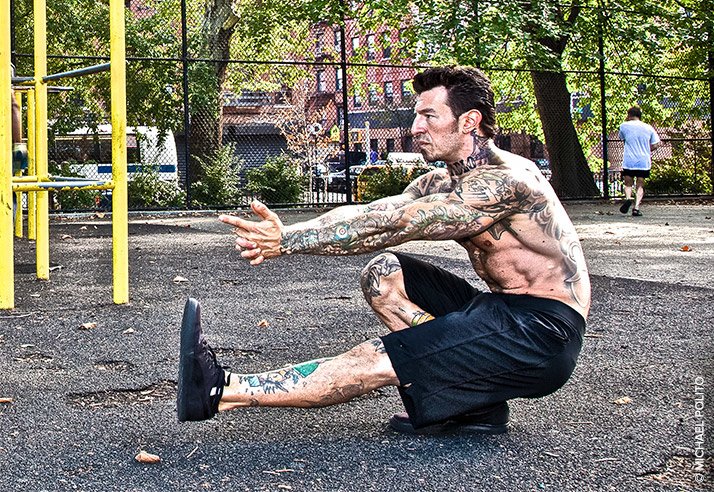
The 7 Do's And Don'ts Of Bodyweight Strength
Training to be a bodyweight boss comes with a special set of rules—and consequences. Listen up now, so you don't end up face-down on the asphalt later!
On the road to strength, there are many paths we can choose. Barbells, dumbbells, or kettlebells? Elastic bands, medicine balls, or bulky machines? All of the above, or none? There are many conflicting views out there, but those familiar with my work know exactly where I stand: To get everything you want out of life and fitness, you don't need much
Wherever your stance, it's an indisputable fact that to get big and/or strong you must challenge your muscles against resistance. This is life. However, that resistance does not necessarily have to be an external object. In fact, your own body, the laws of gravity, and dear, sweet Mother Nature in her infinite splendor provide all the resistance you need to get stronger than you've ever been in your entire life.
This is how you get strong using body weight only. Here's the straight dope, right from the heart. The voice of experience. Brace yourself, because it may not be what you're used to hearing.
1 Do embrace relative strength
Different goals require different forms of practice. For example, if you dream of bench pressing 400 pounds, your training will require heavy bench pressing. This is certainly is a noble goal, but it's definitely not my goal. Who's stronger: the guy who can bench 400 pounds, or the guy who can do 20 perfect one-arm push-ups? If you ask me, I'll tell you it ain't the first guy!

The strength I'm interested in, and which calisthenics develops, is raw, honest strength—the type that builds what I've referred to in the past as a "calisthenics body." It's pound-for-pound strength—not the type of strength to move stuff around, but the type of strength to move yourself around. That's how I define it, and if you want to build it, you need to take it every bit as seriously as the big bencher takes his barbell.
2 Do exploit physics

People always ask me how it's possible to increase resistance in calisthenics training. After all, the body weighs what it weighs. Since we can't move the pin on the weight stack or stick an additional 2-1/2 pounds on either end of the barbell, we've gotta be creative!
When you're no longer making strength gains from hammering out those push-ups, adjusting your leverage is the first stop. Here are three techniques to try:
- Elevate your feet to put more weight on your hands.
- Lower the hand position on your body, keeping them closer to your waist and farther from your shoulders.
- Use a narrower grip, which moves the load onto smaller muscles like the triceps.
You can add greater "weight" to any body part by decreasing your points of contact with the universe. One-arm push-ups and self-assisted one-arm push-up varieties will both give you amazing raw strength gains. Naturally, single-leg squats, unilateral bridging, and one-arm pull-ups are also amazing examples that further illustrate this point.
Free your mind from the numbers game, and your body will follow!
3 Do aim for precision
I'm a firm believer that strength is every bit as much neurological as it is musculoskeletal. In other words, keep 'em clean, kids. We want to program our brains and nervous system to learn the patterns that make us work the hardest.
When I started lifting weights in high school, we were always told to "squeeze out" those last few reps. These were often referred to as "forced reps," but I think a more appropriate name would be "sloppy reps."
Now hear me out. There's nothing wrong with embracing those extra reps when training for hypertrophy, provided you do it safely. After all, you've gotta tear up the muscle for it to repair and come back bigger. Additionally, some forgiveness on form can occasionally be granted when learning a brand new move or skill. Doing something poorly is often the first step toward doing it somewhat well—and ultimately doing it really well. But make no mistake: For raw, pound for pound strength—our goal in this article—we want precision.

If you're looking to make your upper body strong, beastly, and powerful, perform your pull-ups until your chin completely clears the bar, with no kink in the knee. Hell, try them behind the neck if your shoulders can handle it. Just make sure you move slowly, deliberately, and in a controlled manner on both the concentric and eccentric motions like a well-oiled machine. No kip. No swing. No bull!
4 Do respect progressions
For sheer strength you're better off doing low reps of perfect sets with ample recovery time in between. In progressive calisthenic strength training, this usually means you will need to do the hardest exercises in your arsenal, with respect to your individual skill level.
You may be better off performing 3-6 hanging straight-leg raises—provided you can do them well—than 20 hanging knee raises if your goal is indomitable abdominal power to go along with your diamond-cut abs. As I previously mentioned, pay attention to form, because if it suffers, so will your neurological programming and therefore your strength gains.
We as a culture are often encouraged to take shortcuts and go for the quick fix. For shame. To make real progress in anything, we need to respect the journey, not just the goal.
5 Don't be afraid to regress

Remember what I said about respecting progressions? Well, regressions deserve just as much of your esteem. Just as elevating the lower body places more emphasis on the chest and arms when performing a push-up, elevating the upper body places less. If you're having a hard time down there on the floor, step back and perform your push-ups with your hands on a bench or other surface. The higher you go, the more forgiving the push-up—and the more precise you'll be able to be.
This same principle applies to almost every other exercise as well. If you were to compare pull-ups to bodyweight rows—also known as Australian pull-ups because they require you to get "down under" the bar—you'd find that the row is a regression, and may be more appropriate for particular trainees. No shame in that game. We all must respect our level.
It's easy to watch a YouTube video of someone performing flawless one-legged squats and think it's a fine starting point, but that's not the case for most people. It certainly wasn't for me. I distinctly remember humbly busting my ass the first time I tried a pistol squat.
Honestly, it took me years to go from squats, to lunges, to Cossack squats, to assisted single-leg variations. These days my pistol squats are flawless, but this wouldn't be the case if I didn't regress when it was appropriate. This goes doubly so for elite movements like the human flag!
6 Don't go to failure
Again, strength is different than size. Although the most advanced bodyweight warriors often possess an incredibly high strength-to-mass ratio, they are not necessarily the biggest guys in the room.
Training to muscular failure is frequently recommended when training for size, but when sheer strength is the goal, I recommend leaving a little gas in the tank. Doing so will allow you to spread your concentrated reps over more sets, rather than going balls-out and exhausting your body.
Of course I enjoy working as hard as possible, but not necessarily as much as possible. I find that intense and concise workouts that don't leave me winded and beaten down allow me to train with a greater intensity and devote more of my time to the practice of getting strong.
7 Don't let the haters bring you down
There will always be haters in all walks of life. In the fitness world, it used to be limited to some know-it-all in the gym loudly declaring, "You're doing it wrong!" In the Internet age, unconstructive criticism is more rampant than ever.

Many times, folks will hide behind their keyboards and offer everything from misinformed advice to plain old nastiness. All I can say is, don't take the bait. When you argue with a fool, there will be two idiots in the room instead of one. Just do your thing, friend!
In the world of fitness, all goals are good goals. You wanna get strong? Big? Fast? Fantastic! Is your technique different than mine? Wonderful! All disciplines in fitness have elements in common. We all do better when we support one another.
If you have any do's or don'ts that I left out, please let me know in the comments below. Until next time, keep on killin' it, my bodyweight brothers and sisters, and keep the dream alive!

